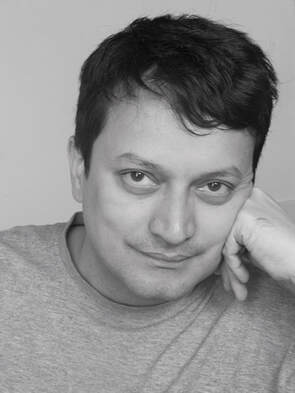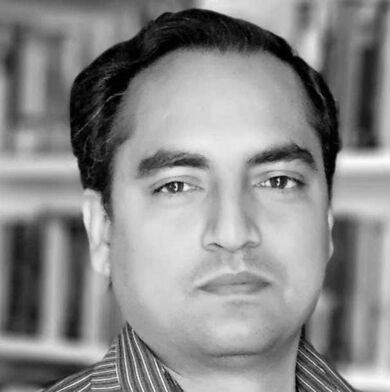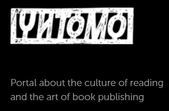Talismanic Utterance: Ranjit Hoskote in conversation with Sarabjeet Garcha
Ranjit Hoskote is among the foremost poets of India today. For three decades, he has been writing poems that stand out for their luminescence, intensity and virtuosity. The lines he sculpts make possible a selective evanescence, in that they leave behind the permanent residue of image even after memory, with the passage of time, chooses to swallow the words. The way he follows instinct rather than literary fashion during composition makes him a distinct presence among his peers, one who – in the exuberance of experimentation – never steers his gaze away from the altar of pure poetry. Connoisseur of image and master of metaphor, Hoskote has also contributed to the essential tradition of translation with his remarkable rendition of the fourteenth-century Kashmiri mystic-poet Lal Ded as well as the Marathi poet Vasant Abaji Dahake. His essays on art and culture, too, dwell in the sublime dual space of erudition and agility.
In this conversation with Sarabjeet Garcha, Ranjit Hoskote shares the stories, beliefs, approaches and observances that shaped his art.
In this conversation with Sarabjeet Garcha, Ranjit Hoskote shares the stories, beliefs, approaches and observances that shaped his art.
SG: You are labelled a Bombay poet, but a close reading of your work reveals you as a nature poet whose engagement with several borderless realms of existence erases labels. How do you see yourself?
RH: I have always disliked the label of ‘city poet’. I love the city – after all, I was born in Bombay and have lived here for most of my life – but my consciousness and sensibility were shaped far more by my early childhood years in Goa. We lived in a house on a hill, with a bamboo grove below us on one side and wooded slopes rising gently behind. In the 1970s, with no pollution to mar the atmosphere, the night sky was a tapestry of stars. The life of flora and fauna was close at hand. And to grow up by the sea, in close proximity to riverine estuaries and wetlands, is also an education in mobility across borders. You learn how realms transit gradually into each other, how osmotic boundaries in fact are. So I see myself as traversing several domains, the immediate and material as well as the more distant and transcendent, the urgent and the perennial.
SG: Does translating a mystic like Lal Ded alter the translator’s belief? Are you a believer?
RH: I came to Lal Ded as someone who wished to restore a connection to a homeland, Kashmir, and a language, Kashmiri, lost in the experience of diaspora. Very soon, however, this ethnic nostalgia was superseded by an apprenticeship to the poetry itself – its tonalities, the way in which language shifts and re-calibrates itself across the centuries, the modes by which the Divine is approached while the worldly is not disregarded, the manner in which deep experiences of interiority and quest are conveyed through some of these utterances, while other utterances in the corpus offer wise counsel, pragmatic advice.
I was brought up in a family environment that drew eclectically and ecumenically on plural religious imaginations. There was a family connection with Theosophy and J Krishnamurti, going back several generations; my mother was a Shaiva in her own belief system but open to the aesthetic flowering of the Vaishnava systems, my father is a self-declared agnostic; both my father and I went to Christian schools, he to a Jesuit boarding school and I to a Presbyterian school, so the worlds of Judaism and Christianity were organically present to me; my parents made sure that I read Hindu, Buddhist, and Sufi texts, that I reached out to the Sikh, Zoroastrian and other traditions.
However, when I began to translate Lalla, I was still a student, and caught up with a Leftist politics that was sceptical of the role of religion in collective life. Over the years – the 20 years that I took to translate Lalla were also the worst years in Kashmir’s violent, tragic history – I arrived at various resolutions to these questions. I realised that organized religion and politicized religiosity are certainly dangerous and narrow the human adventure and the spiritual quest – but they do not circumscribe it. That was a key lesson that I learned from Lalla.
In my first round of translations of Lalla’s vaakhs, done when I was in my early twenties, between 1991 and 1993, I had been caught up with finding what I felt were secular interpretations of her spiritual accounts. Soon, I put this preliminary work away and started afresh, acknowledging what I had always known – that the Yogic terminology and the Tantric symbolism were not incidental, but central to her oeuvre. I was not going to play secular Procrustes and trim the original to suit my ideology; rather, my ideology was going to give way in the presence of the original. This, along with my rigorous linguistic analysis of the vaakhs, showed me clearly that the Lal Ded corpus is, in fact, the work of what I call a ‘contributory lineage’ across the centuries, embracing men and women, Hindus and Muslims, Pandit reciters and Sufi sages, peasants and scribes. I opened myself out to this plurality of sources, traces, genealogies. As I write in my Introduction to I, Lalla: The Poems of Lal Ded (2011), the translator is broken and re-made through the process of translation.
As part of that process, I have come firmly to recognize that it is my anchorage in an ecumenical, inclusive, pluralist spirituality that allows me to reach out – with empathy and in solidarity – to those who hold other beliefs or perspectives, especially those rendered vulnerable or marginal by political processes. It gives me an amplified sense of the sacred that extends beyond names and forms, nama-rupa, and is to be found in all the wisdom traditions. It allows me to appreciate the importance of a quest for the transcendent that must proceed alongside a compassion for sentient beings that grounds such a quest in the here and now.
SG: Was it poetry that brought you so close to the world of painting, or was it the other way round?
RH: I turn, again, to my childhood years and to my adolescence. I was brought up in a family that regarded the arts and culture as central to life, not as optional extras. And as I grew up, I found myself in an ethos – in the Bombay of the late 1980s – where conversations and collaborations took place across the arts, with poets, film-makers, architects, theatre-makers, and painters all comparing notes and exchanging ideas.
Among my earliest memories is the sound of the music that my parents played on their Garrard turntable, their 45 rpms and LPs – Rimsky-Korsakov’s ‘Scheherazade’, Vilayat Khan-saheb’s raag Yaman, Emilio Pericoli singing ‘Al Di La’, Khachaturian’s ‘Spartacus’, Bismillah Khan-saheb’s raag Durga, Ravi Shankar and Ali Akbar Khan in concert. So cadence, tempo, flow, atmosphere, and colour came first, even before they were elaborated, for me, into any specific art.
My parents encouraged me in whatever creative endeavours I embarked on as a child, so I used to spend hours drawing and painting, and would also write. My relationship to the arts has always been starfish-like, leaping out in different directions from a single starting point – music, architecture, literature, and the visual arts. However different my engagement with each of these practices may seem – in the visual arts, I draw on the productive paradox between abstraction and materiality; in poetry, I work with the interweaving of text and musicality – what holds it all together is my curiosity about, and my commitment to, the lived experience of confluence, the coming together of dissimilar impulses or energies, and the way in which they produce something unexpected, unpredictable, vibrant, and expansive.
SG: Your poems are carnivals of images, but the path to each carnival passes through distinct villages of sound. How do you marry the visual to the aural while keeping yourself free from the demands of formalism? Is thorough craftmanship enough for poetry?
RH: That is such a beautiful and generous way of describing my poems! Thank you, Sarabjeet.
Growing up, I assumed everyone was synaesthetic, because I was. On reading Oliver Sacks, I realised that, in fact, I belong to a minority of people who actually have synaesthesia – a condition in which a stimulus made primarily to one sense can be experienced, in translation as it were, by another sense. A sound as a colour, or a colour as a sound, for instance. The link between the visual and the aural in my poetry has a neurological basis, and also is in accord with my lifelong awareness of the closeness of these two aesthetic physiologies, that of the listener and that of the viewer.
On the subject of formalism, while I have the greatest appreciation for form – without which we would be lost – I would like to remake my language to engage afresh with various domains of experience, to experiment continually. Formalism of any kind tends to become caught up with the inner logic of the art work, its technical determinations and the unfolding of their structural possibilities. This is vital to how we create works in any art form – but it cannot, for me, be the purpose of the art work. To me, true craftsmanship is articulated, not by following magisterial templates, but through the artisanal process with its interplay of practiced measure and unforeseen discovery – which generates its own purposes, its own mysteries, its own illuminations.
SG: Some of your recent poems, particularly in The Atlas of Lost Beliefs, have a Merwinesque approach to punctuation, or rather the lack of it. How did that come about?
RH: I have moved gradually, as you say, to a form without punctuation. My journey towards this point has been charted through a decade or more of translating Urdu poetry, specifically the ghazals of Mir and Ghalib. Along the way, I saw that the subtleties and multiple legibilities of Mir and Ghalib came from the syntactic freedom that Urdu permits, its cunning slippages between subject and predicate, its delightful gift for suppressing the subject of an action, its diaphanous use of suffixes like ‘-sa’, which could mean ‘like’, ‘somewhat’, ‘a touch of’, ‘a hint of’, and so forth. How might one bring that over into English? This led me to dropping punctuation and shaping my lines through a mise-en-page that imparts to the reader the responsibility of tracing the patterns by which the poem can be read. I celebrate the plasticity of line and the movement of the poem in space, and through the voice.
SG: In a world obsessed with bestsellers, what is the role of serious poets, who can at best hope to sell a few hundred copies?
RH: The way poetry inflects consciousness cannot be measured only by the number of copies sold. Poetry has, as you well know, a way of surviving in proverb and fable, allusion and talismanic utterance. Sometimes, we must trust in forms of quantification that span generations in time, rather than being defined by the volume of a print run.
SG: Is obscurity a prerequisite for the growth of a poet? In his introduction to The Book of Indian Essays: Two Hundred Years of English Prose, Arvind Krishna Mehrotra refers to the 'modern Indian author, especially the one that writes in English', as one who, 'because of the prevailing culture of book promotion, does little except preen and hustle, hustle and preen. And who constantly asks, with a worried look, ‘Mirror, mirror, on the wall, who is the fairest of us all’.' Is a poet fairer by virtue of obscurity, whether voluntary or imposed?
RH: Willful obscurity can be an impediment. Or not. Sometimes, especially in the early phase of a poet’s career, a striving to explore difficulties may come across as obscurity. Dissonance, rupture, syncopation – all these may strike a reader as exercises in deliberate obscurity, but may be attempts to open up new conceptual and sensuous experiences, new aesthetic ground, a new embrace of the political. I have not read Arvind’s new anthology yet. I agree that we have had far too much of the “preen and hustle” culture, of course, and am impatient with its shallowness.
SG: Besides English, you also read widely in other languages such as Hindi and Marathi. What similarities and differences have you observed between the present-day poetry in these languages?
RH: To speak directly from the books in Hindi and Marathi that I have been reading during the pandemic and lockdown, I see a fine experimentalism in the work of the Marathi poet Mangesh Narayanrao Kale – I’ve been immersed in his book, Maayaaviye Tehrir – who injects into the bloodstream of an over-Sanskritized modern Marathi a dose of Persian and Urdu. He challenges his readers, both in aesthetic and in political terms. He demands close attention, which is rewarded by an amplification of our horizons.
I have also been re-reading Mangalesh Dabral, who most unfortunately passed away a few days ago. His poems will stand for all time. I admire his play of scale, the adroitness with which he yokes the neighbourhood and the universe together in the compass of a verse. I admire the suppleness of his language, the everyday and the startlingly epiphanic flowing together.
SG: How relevant is the guru-shishya parampara in Indian poetry in English today, particularly vis-à-vis a culture that favours irreverence?
RH: I prefer the model of the gharana, a ‘family lineage’ in Hindustani classical music – which I have described, elsewhere, as an ‘experimental continuity’. There is a lineage with its heirlooms and talismans, but there is also the practice of listening and looking at things that happen outside the lineage; there is overhearing and trying out; there can be, even, a mutuality of education. That was my own experience as a young, a very young poet who received much generosity of spirit and practical advice from Nissim Ezekiel, Dom Moraes, Adil Jussawalla, Dilip Chitre, Keki Daruwalla, Arun Kolatkar, and Agha Shahid Ali.
And so the gharana, at its best – or at least in my rather utopian version of it – can achieve a synthesis of traditional inheritance and new expressivity. My fear, with the more strictly imagined guru-shishya parampara, is that it can become fixated on hierarchy, with all authority flowing from above and all obedience flowing from below.
SG: Although your lines have been becoming longer, they seem to exude a silence that is almost spiritual, yet you’ve never made claims to spiritualism. What is happening exactly?
RH: I’ve always been fascinated by Sri Ramakrishna’s image of the jivan-mukta as a heron – a bird that stands in the water, with its feet in the mud of the lake, but which never allows the mud to touch its wings.
SG: ‘The Poet’s Life’, the ultimate poem in both Jonahwhale and The Atlas of Lost Beliefs, has 21 lines, each a complete sentence, end-stopped. It’s your only poem written in this style. It’s as if you’ve been approaching this simplicity for years. How did the poem come about?
RH: I have a great fondness for anaphora, the rhetorical schema in which every line or verse begins with the same word or phrase. It comes from deep within the oral tradition. It makes for a percussive reiteration – not a simple repetition, since you’re brought back to where you began before, but invited on a different journey. That’s what happens in ‘The Poet’s Life’. Every line begins with ‘He’, and the details of what the subject of this miniature biography does keep shifting between the prosaic and the eccentric, the worldly and the surreal.
With this poem, I also wanted to essay, literally, a brief biography of a poet composed from varied figures – some of the details are literally accurate! Some come from my life, some from the life of Pablo Neruda, yet others from the lives of other poets. Another dimension of the poem is a lightly etched ars poetica, a manifesto of a certain kind of poetry.
SG: You often talk of satsang for poets. How relevant is that in the present day?
Satsang – the company of those who sustain one another in the hygiene of the self – is highly relevant today. Toxicity cannot be the basis for a productive community. I am saddened to see that, all too often, people are united by a shared resentment, a common discord.
SG: Do you have a message for fellow poets?
RH: Yes. There’s a very thin line between fishing and standing on the shore looking like an idiot.






